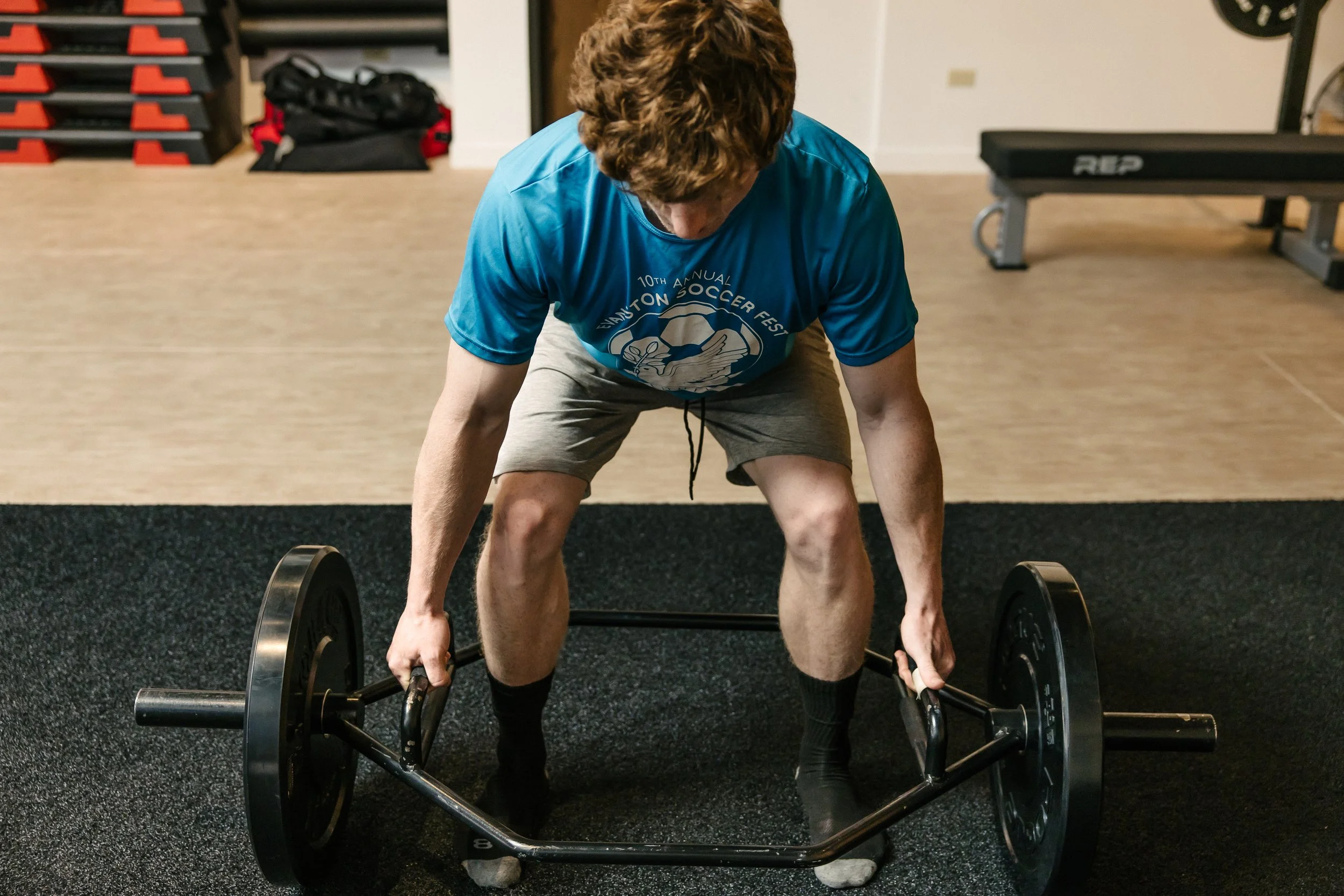What Muscles Does the Deadlift Work?
It’s important to develop a strong lower body as we age. The deadlift builds some of the largest muscles in the body, including the glutes, making it ideal for athletic performance or everyday life. Photo Credit: Becca Heuer.
As we age, maintaining muscle mass and strength becomes increasingly important. The deadlift is a powerhouse exercise that offers tremendous benefits.
But what muscles exactly does this fundamental movement target in our bodies? Let's dive deep into the biomechanics. This will get you the best results from the deadlift, whether you're competing in a sport or maximizing your healthspan.
The Deadlift: A Full-Body Powerhouse
Many experts consider the deadlift the king of all exercises, and for good reason.
As a compound movement, it requires strength and coordination across many muscle groups. This efficiency is crucial as we balance fitness with busy lives and the need for adequate recovery time.
The deadlift trains explicitly the hip hinge. This is a crucial movement pattern that translates to everyday and athletic strength. Engaging the powerful glute muscles and the entire posterior chain limits injury risk to the lower back.
Primary Muscle Groups Worked
Conventional deadlifts and sumo deadlifts work the same muscles with slightly different emphases. It can make sense to cycle through each to get the most benefit.
Lower Back (Erector Spinae)
The erector spinae, a group of muscles that run along your spine, play a crucial role in the deadlift. They stabilize the back dynamically. Many of my clients will report improved lower back pain after learning the movement correctly. This results from strengthening the erectors directly and better supporting them with glute max engagement.
Glutes (Gluteus Maximus, Gluteus medius, and Gluteus minimus)
Your glutes are powerhouse muscles that receive a massive stimulus from the deadlift. They drive hip extension, which influences posture, pain relief, and athletic performance. As a bonus, engaging them during that lift can require practice and focus. That means you're developing strength along with a mind-muscle connection.
Hamstrings
The hamstrings work in tandem with the glutes to extend the hips during the deadlift. They also play a role in knee flexion as you lower the weight. Strengthening the hamstrings can improve overall leg strength and help prevent common injuries. Runners or sports with significant sprinting, such as soccer, disproportionally experience hamstring strains.
Secondary Muscle Groups
Quadriceps
While the quadriceps have a part in the deadlift, they're easily overemphasized. Think of them as stabilizers to the hamstrings rather than primary movers. That will avoid turning the deadlift into a squat.
Trapezius and Rhomboids
The upper back muscles, including the trapezius and rhomboids, keep the shoulder blades retracted throughout the lift. This is important to avoid any shrugging motions, particularly at lockout.
Latissimus Dorsi
The lats play a role in keeping the bar close to your body during the lift. You'll often hear coaches cue lifters to "pack the lats." This drives the bar into the shins and creates stability and tension from the shoulders to the lower back.
Forearms and Grip Muscles
Holding onto a heavy barbell challenges your grip strength, engaging the muscles in your forearms. This has direct implications for healthy aging. Many research studies show that grip strength correlates with independence and mobility.
Abdominals and Obliques
Your core muscles work isometrically throughout the deadlift to stabilize your spine and maintain a neutral position. You can also think of your abs and obliques as providing "anti-rotation." Preventing the weight from twisting your body to either side is vital for general power and athletic development.
Benefits of Deadlifting
The deadlift works more than the muscles. It provides several other benefits that translate to healthspan and athletic performance.
1. Increased Bone Density
Weight-bearing exercises like the deadlift prevent decreases in bone density over time. This lessens the risk of fractures from falls in later life.
2. Improved Hormone Profile
Compound exercises like the deadlift can boost testosterone and growth hormone production. These hormones are crucial for maintaining muscle mass and overall vitality.
3. Enhanced Functional Strength
The deadlift mimics real-life movements like picking up heavy objects from the ground. This translates to improved strength for everyday activities, helping maintain independence as we age.
4. Better Posture
As the name implies, the posterior chain refers to a series of connected structures. Improving posture begins with the hips and continues upward through the shoulders. Most posture issues are caused by the tightening of the neck and upper traps in response to weak links much further down.
5. Increased Metabolism
Muscle burns more calories than fat. In addition, the deadlift reduces injury risks that tend to keep people from exercising more frequently. Layoffs typically lead to weight gain because of decreased caloric expenditure.
Tips for Maximizing the Deadlifting
A few basic principles will maximize your deadlift. Read my article at this link for technical advice.
1. Consider the hands
Deadlifts primarily use the overhand grip. At a certain point, however, gripping the bar this way becomes the limiting factor in completing your sets.
Depending on your sport, including a mix of sumo deadlifts and conventional deadlifts can lead to excellent results.
Use a hook grip or listing straps rather than allowing this weak point to overshadow your glute and hamstring development. I prefer these to a mixed grip, which can lead to misalignments and imbalances. My favorite straps come from Iron Mind.
2. Prime the pump
Many lifters get into position by just dropping their knees until they can reach the bar. A better approach is to send your hips behind your first while your knees remain straight. By creating tension in the posterior chain and squeezing your glutes, you're signaling to your brain the primary muscles to work.
After you've created a tight backside, you can slightly bend the knees to grip the bar. This also allows you to keep your shins straight.
Deadlift variations like the trap bar deadlift can provide a better stimulus or feel more comfortable for some people.
3. Explore deadlift variations
Even if you compete in powerlifting, you should find alternatives that give you the best pump. Here are a few options based on their benefits:
Focusing on the eccentric (lowering phase): Romanian deadlift (RDL), b-stance RDL, stiff-legged deadlift
Developing balance and coordination: Single-led RDL, landmine single-leg RDL
Limiting back fatigue: trap bar deadlifts, hip thrusts
Practicing technique: pause deadlifts, Boris deadlifts, block pulls, deficit deadlifts
5. Practice patience
Rushing is one of the major issues I see with coaching the deadlift. Take a moment to position the barbell with your feet about 1 inch from the shins. Place your feet hip-width, and rotate the hips outward slightly.
After setting your position, avoid over-powering the movement right at the start. Instead, pull the slack out of the bar and drive the hips out. Once the bar breaks off the ground, squeeze the glutes as hard as possible while sending the hips forward aggressively. Continue driving the hips into you're in a full standing position.
Conclusion
Few exercises produce full-body strength and power like the deadlift.
It offers a time-efficient way to build strength and coordination and enhance overall functional fitness. For those over 40, the movement counteracts some of the normal wear on the spine while building the largest muscles in the body.
Some people will claim that the deadlift presents significant risks.
However, following general training principles decreases these significantly.
Start conservatively. Choose an appropriate amount of weight to start. Work up to a number at which you could confidently perform two more reps.
Progress intelligently. Add weight or reps as you get stronger, as long as you recover well between workouts.
Substitute accordingly. If the barbell versions feel painful, find alternative hip hinge movements. Even a glute bridge can be an effective variation based on your experience level.
More importantly, any exercise has risks, so focus on the payoff. The deadlift potentially lessens back pain by getting you stronger in a movement you do every day. Avoidance is rarely a good solution.



